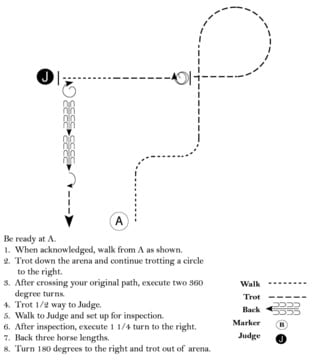Multiple World and Congress Champion trainer and AQHA judge Charlene Carter sat down with GoHorseShow and discussed this year’s 12-14 and 15-18 Youth Showmanship Congress pattern. We thought it would be beneficial to our readers to hear from an AQHA Judge, whose customers have had success in this class, how the patterns should be executed.
Charlene Carter, along with her husband Mike, own and operate Carter Show Horses, in Goodlettsville, Tennessee. They have successfully trained and shown AQHA World and Congress Champions in numerous all around events. One of Carter’s specialties and favorite classes is the showmanship and it shows in her passionate discussion of this pattern. Carter was the recent showmanship clinician at the 2013 Novice East Championships.
As far as why GoHorseShow chose the 12-14/15-18 Youth Showmanship Pattern, we wanted to breakdown the harder patterns because the novice patterns tend to have many of the same maneuvers. We would also like to thank HorseShowPatterns.com for letting us post the pattern in the article as well as provide a link to the pattern. Please print out the pattern and follow along or click here to download the pattern. **Note–12-14 and 15-18 Patterns are the same.
Let’s see what Charlene has to say!
Congress Showmanship Breakdown
 Being the last number called out, that’s how they announce the Champion at the Congress, begins long before you walk up to start your showmanship pattern. Your dedication will play a big part in your success. You will want to spend the time developing your timing with your horse. It’s up to you to make the decision that you want to be great in this class. This is a class that demands a lot of perfect practice. If you can’t set your horse up within a couple of moves, then you need to put more time into your showmanship. Yes I know, I hear it all the time, “My horse stays at my trainers.” So I ask again, “Do you want to be the last number called out?” Use the time you do spend with your horse effectively. Have fun, spend time with your friends, but you have got to dedicate yourself to your horse. If you can’t perform the maneuvers outside the show pen, they will not miraculously happen when you walk into the arena.
Being the last number called out, that’s how they announce the Champion at the Congress, begins long before you walk up to start your showmanship pattern. Your dedication will play a big part in your success. You will want to spend the time developing your timing with your horse. It’s up to you to make the decision that you want to be great in this class. This is a class that demands a lot of perfect practice. If you can’t set your horse up within a couple of moves, then you need to put more time into your showmanship. Yes I know, I hear it all the time, “My horse stays at my trainers.” So I ask again, “Do you want to be the last number called out?” Use the time you do spend with your horse effectively. Have fun, spend time with your friends, but you have got to dedicate yourself to your horse. If you can’t perform the maneuvers outside the show pen, they will not miraculously happen when you walk into the arena.
- Be ready at marker A. I feel that consciously or unconsciously, when the judges take their first look at you and your horse, they put you mentally into the top, middle or bottom of the class. Be sure that the top is where you start. You can have a few weak spots and still stay in the top group, but when you start out in the middle or bottom and make any missteps, it’s hard to end in the top bracket. It goes without saying, you want to have a perfect setup when you start at the first cone. The ring stewards at the Congress are excellent and will give you plenty of time to get that perfect setup. Take your time and get it right. Be sure that you have your horse’s spine straight, and I personally like the horse’s head slightly up for the setups only. It is critical, that you let the judges know that you are confident, effective and ready to give them that pattern that they are looking for! We as judges are waiting for that exhibitor that will be our winner.
- When acknowledged, walk from A as shown: As you move to depart, your horse’s head should drop to level and remain there for the remainder of the pattern while in motion. Your departure needs to be smooth and as you step out with your right leg, your horse needs to immediately step out with you. With the one marker only, you will need to evaluate the distance to the ring steward. You really want to lay out this pattern as close to the drawing as possible; however, the written directions in all patterns, always take precedence. The judges will be looking for the exhibitor that can walk with purpose and a horse that willingly keeps his position.
- Trot down the arena and continue trotting a circle to the right: With a reasonable amount of speed, smoothly and precisely flow into a trot, as you pass the ring steward, get a feel for where you will need to close your trot circle. Do not look over at the ring steward. Not only is it dangerous to not look where you are going, it shows your lack of your sense of space. You will be on the outside of the circle; therefore, you will need to be sure to keep your position. If you fall behind, then your horse’s spine will become inverted and the inside shoulder will drop. This circle needs to be done with your horse keeping his frame upright and his spine softly bent as the drawing shows. As you start to close your circle, you must find the ring steward with minimal visible adjustments. As you prepare for your stop, slightly increase your speed, this will help your horse stop with his feet better balanced underneath him.
- After crossing your original path, execute two 360 degree turns: You must be sure to cross your original path. Your spins need to be smooth, natural and continuous with even cadence. I have found that having your horse take four even distanced steps with his left foot, per each 360 and keeping that foot coming underneath his frame keeping his spine straight will make for a credit earning maneuver. This raises the degree of difficulty, and, in this deep class, you will need all of the extra credits that you can merit. As far as your position in the turns, be sure that you keep your body framed even toward your horse. Remember that both of your shoulders should be the same distance from your horse’s straight and level neck. Right before you close your second spin, find your ring steward. Make a decision as to where to close the spin. Hopefully, you will have tracked straight to the judge for your stop; however, if you stopped a little off, you can make a minimal adjustment on where you start your spin.
- Trot 1/2 way to judge: This departure needs to be smooth, with your horse moving freely beside you with a reasonable amount of speed.
- Walk to Judge and set up for inspection: The down transition needs to be precise and immediate. If you will lean back ever so slightly, your horse should read off your body language if you have done your homework. You and your horse should be in sync on your timing for this downward transition. This is one of those maneuvers that the judges will really be watching for faults of the exhibitor walking and the horse continuing to trot or vice-versa. Practice this maneuver and have confidence that you can nail it! The next maneuver is the setup and inspection. This is one of the most important parts of the pattern. It is critical that you are lined up in front of the ring steward. Again, the horse’s spine needs to be straight. Enough practice should raise your chances of having a perfect setup with a reasonable amount of moves. Precision should not be sacrificed for speed; however, after a couple of moves, your score could start falling. Practice, practice, practice! Your crossovers need to be smooth and have an equal distance on both sides of your horse’s head. You can practice your steps at home, no excuses for these not being correct. Also remember, to keep your horse’s head slightly up and completely straight. Be sure that you do not inadvertently pull his head as you cross over. As far as the smile is concerned, if you can have a big smile and it looks natural, then go for it. The really fake smile is not appealing to most of the judges that I have had the privilege to discuss this with.
- After inspection, execute 1 ¼ turn to the right: Here again, you want to perform those smooth even flowing spins. Keep your steps and distance from your horse the same throughout the spin. In order for your next maneuver to start out straight, you have to complete your spin at the exact straight imaginary line.
- Back three horse lengths: Wow, this is a long way and will be a deal breaker. This should be around twelve steps. Ideally, your left shoulder should be in alignment with your horse’s left front leg. Getting any deeper into your horse’s space should result in a severe fault. Keeping your horse’s spin straight will help insure that your back will be straight. If you push his nose away from you, his rear will go to your right. If you pull his head toward you, his rear will go to your left. You can also use this cause and effect to minimally fix the back before you get off track. The back needs to be smooth and responsive with minimal visual or audible cues. Loud clicks and clucks are very distracting to most of the judges. Practice keeping the spine straight, the head level and the horse’s head not changing his natural position. The head and neck must not bend or get behind the vertical. With your next maneuver being a spin, you must be sure that you stop your back with the pivot foot solidly underneath your horse’s rear. This will prevent any extra steps or step outs.
- Turn 180 degrees to the right and trot out of arena: As mentioned before, it is paramount that you stop your back with the pivot foot solidly underneath your horse’s weight in order to hold that pivot foot. If you stop with it out to far back, even if you stick the turn, it will not look very smooth and with this being the last maneuver, you want to finish with the judges having a very positive feeling about your performance. After you complete the 180, make a smooth departure at the trot. Keep showing until you have exited the arena. I feel that it is absolutely not necessary to nod to the judges or ring steward in fact this is a little outdated technique.
Be sure to read the AQHA Rule Book! You need a good understanding of the scoring system! Good luck and congratulations to the winner! Will it be YOU?







